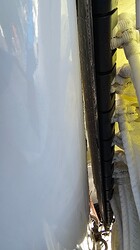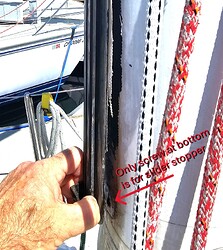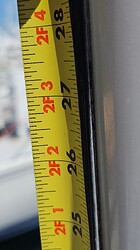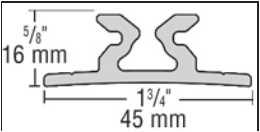I’ve been working with epoxy in many different situations and both commercially and privately since 1976. I’m pretty confident with it, but I’m still always very cautious in a new situation. It is amazing stuff if done right, but can fail in surprising ways and working with it is unlike anything else you’ve probably done. So what I’m getting at is: don’t trust to luck. Practice first. Mix some epoxy, soak some cloth, hang it on a vertical surface, see how it behaves. Screw a piece of aluminum bar to your vertical test surface and see what it takes to get it up behind there. Watch how it runs (and remember that you don’t want any starved joints, so you need to make sure the epoxy doesn’t run out of the upper end of the strip while you are positioning it.)
Be thorough in your preparation cleaning. There are things that epoxy does not stick to and you don’t want them in your joint!
He mentioned removing the masking, but not applying it.  You’ll want to mask the edges of your repair prior to doing your dry run. The rest can come at any time before you actually mix the epoxy. When it comes to the actual job, mask the hell out of everything. It’s not like painting. The stuff runs very freely and you need squeeze-out to ensure the fiberglass tape is well filled with epoxy. So plan to have epoxy running down your mast. Which really means, tape enough plastic sheeting below the repair so the squeeze-out will run down onto that and not your hardware or your deck. You’ll want to mask around your actual repair with electrical tape because the epoxy can wick beneath regular masking tape. Be sure and wipe the excess epoxy off of the masking before it sets, though, or it will be hard to get the tape off and you will be left with an ugly ridge where the edge of it was. The epoxy will begin to gel at the end of the working time and that’s when he suggests removing the tape. If that does leave a little ridge you can probably wipe it very gently with the corner of a credit card to burnish it down. Start in a less visible area to be sure you’ve got the hang of it and you might need to wait until the gel is at the right stage. I’m just kind of guessing because I’ve never done the exact repair you are doing. It’s just what I would be thinking of if I were doing it on my own mast.
You’ll want to mask the edges of your repair prior to doing your dry run. The rest can come at any time before you actually mix the epoxy. When it comes to the actual job, mask the hell out of everything. It’s not like painting. The stuff runs very freely and you need squeeze-out to ensure the fiberglass tape is well filled with epoxy. So plan to have epoxy running down your mast. Which really means, tape enough plastic sheeting below the repair so the squeeze-out will run down onto that and not your hardware or your deck. You’ll want to mask around your actual repair with electrical tape because the epoxy can wick beneath regular masking tape. Be sure and wipe the excess epoxy off of the masking before it sets, though, or it will be hard to get the tape off and you will be left with an ugly ridge where the edge of it was. The epoxy will begin to gel at the end of the working time and that’s when he suggests removing the tape. If that does leave a little ridge you can probably wipe it very gently with the corner of a credit card to burnish it down. Start in a less visible area to be sure you’ve got the hang of it and you might need to wait until the gel is at the right stage. I’m just kind of guessing because I’ve never done the exact repair you are doing. It’s just what I would be thinking of if I were doing it on my own mast.
Like so many jobs, preparation is the most important and most time consuming part of it. With epoxy the actual mixing and use will (and must) happen very quickly. So have everything masked, all tools and cleanup stuff at hand, etc.
Edit: include all parts of the process in your dry run including pretending to measure and mix the epoxy to ensure that everything necessary is at hand.
Do not under-mix the epoxy. Epoxy is a cross-linked plastic. You want to make sure that every bonding location gets connected, so mix until you are sure they all will. As you mix it you will see swirliness (my computer doesn’t think that’s a word, but it is now) due to diffraction between the two different components and possibly color differentiation. When mixed it will appear uniform and you will not see those diffraction swirls.
(You weigh the two parts because they are different densities and you need to make sure you really do get the exact correct proportions. And it is the difference between the two densities that creates the diffraction effect.)
Wear some of those blue disposable gloves and make sure they fit well. You don’t need gloves sliding around on your hands or bunching up on your fingertips when the clock is ticking.
Alcohol is nice for prep, but have some acetone on hand for emergency cleanup. You must clean up epoxy before it cures - preferably even before it gels. But don’t let the acetone wick into your actual joint.
Cleanup can be done with blue paper towels or cotton rags. Be sure you don’t leave lint behind, though. Epoxy soaked lint, when cured, becomes like little pokey needles. (Personal experience!) Acetone dissolves some plastics, so if you are inclined to use microfiber cloths, try soaking one in some acetone first to be sure it isn’t going to dissolve and smear a plastic coating over your deck or something.
Did he tell you which epoxy to use?








